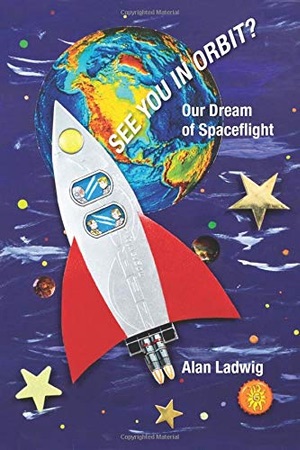Review: See You in Orbit?by Jeff Foust
|
| In the mid-1960s, the Martin Company submitted an unsolicited proposal to NASA calling for a Gemini mission that would fly a National Geographic photojournalist alongside a NASA astronaut. NASA passed on the idea. |
But as the celebration died down, so did interest in the stock. Shares closed that first day of trading down a fraction of a percent, but continued to decline as the week progressed, falling nearly 20 percent by the end of the day Thursday. (Shares rebounded a bit Friday.) The dreams of human spaceflight for the masses have not always fared well against reality.
That history of advances and setbacks is the subject of See You in Orbit? by Alan Ladwig, who spent three tours of duty at NASA from 1981 to 2013. In the 1980s, his work there included managing the agency’s Spaceflight Participant Program, best known for the Teacher In Space competition. His book offers a thorough and entertaining examination of efforts, at NASA and industry, to open up space to more than just test pilots.
Public interest in spaceflight predates the Space Age. Robert Goddard’s early rocket launches in the 1920s generated a deluge of letters from people interested in flying on them, while in the ’50s thousands submitted their name to Hayden Planetarium’s “Interplanetary Tour.” Those letters were little different, Ladwig said, from those that came across his desk in the 1980s seeking rides on the shuttle.
The beginning of the Space Age brought new life to visions of space hotels and vacations on the Moon, but there were also some more near-term proposals. In the mid-1960s, the Martin Company submitted an unsolicited proposal to NASA calling for a Gemini mission that would fly a National Geographic photojournalist alongside a NASA astronaut. The company said that such a flight would increase public interest in the space program since that passenger would be “more like the public” and offer “the straight, unvarnished story” of spaceflight. NASA passed on the idea.
The shuttle era brought new interest in public human spaceflight, given its promise of routine operations and a flight experience that didn’t require extensive training. Journalists sought to fly on the shuttle, while other proposals ranged from celebrities to even a Boy Scout. Only after the shuttle started flying, though, did NASA get serious about setting up plans to fly private citizens.
Ladwig had a front-row seat to that work given his position at NASA, and much of the book dives into the process of establishing procedures for flying ordinary people. Journalists again lobbied to be the first to fly. Ladwig quotes a letter from Jay Barbree, the legendary NBC space reporter, who said that only veteran space reporters—like him—should be considered: “We are the handful of journalists who have paid our dues, who have earned the first seat on the Shuttle.” But a NASA committee decided instead that a teacher should be the first to go, setting in motion the Teacher In Space program that Ladwig oversaw.
| Jay Barbree, the legendary NBC space reporter, wrote that only veteran space reporters—like him—should be considered: “We are the handful of journalists who have paid our dues, who have earned the first seat on the Shuttle.” |
He provides a great insider’s account of that effort, including reactions to the announcement of the program—teachers’ organizations were initially lukewarm to the idea, given the timing of the announcement not long before the 1984 presidential election—the frustration some involved felt when two members of Congress, Sen. Jake Garn and Rep. Bill Nelson, got to fly before a teacher. Ladwig said he expected 80,000 teachers to apply, although only a little more than 10,000 ultimately did. (A few requested extensions, he notes, including one who wrote, “My dog ate the application.”)
By the time NASA selected Christa McAuliffe to fly on the shuttle, the agency was already looking ahead to other competitions. A Journalist In Space program was soon underway (with CBS’s Walter Cronkite the sentimental favorite, Ladwig noted) with a proposal to fly an artist next in line. The day Challenger lifted off on the STS-51-L mission, he recalled, representatives of the journalism organization that was working with NASA to judge the applications were at NASA Headquarters to discuss that effort. The loss of Challenger and its crew brought an end, though, to both the journalist and artist efforts.
Challenger effectively brought an end to that effort to fly private citizens in space, with the exception of Sen. John Glenn’s flight on the shuttle in 1998. (Barbara Morgan, McAuliffe’s backup in the Teacher In Space program, eventually did fly, but only after becoming a full-fledged member of NASA’s astronaut corps.) The future of ordinary people flying in space is now firmly in the hands of the private sector, and the final chapters of Ladwig’s book examines those various efforts, including the failures and setbacks that have pushed that dream of spaceflight into the future.
Some of those companies may revive versions of the competitions that Ladwig managed at NASA in the 1980s: a Blue Origin executive, speaking on a panel at the International Astronautical Congress last month, said the company has plans to reserve seats on its New Shepard vehicle for “people like poets and philosophers and artists” as well as paying customers, but offered no further details.
That dream referred to in the book’s subtitle may now finally be arriving. Virgin Galactic and Blue Origin expect to start carrying people on suborbital flights next year, while Boeing and SpaceX’s commercial crew vehicles are slated to begin orbital flights, initially for NASA astronauts but potentially for private space travelers as well—all long overdue from their original plans. Soon, perhaps, the question mark in the title of the book will no longer be needed.
Note: we are temporarily moderating all comments submitted to deal with a surge in spam.
